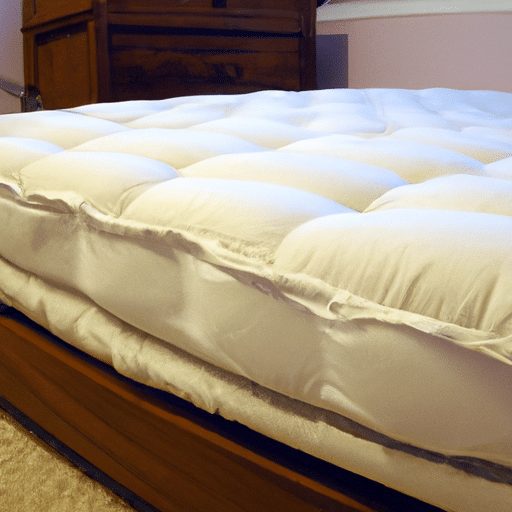When it comes to purchasing a brand new mattress, one burning question often lingers in our minds: how long does it take to break in a new mattress? It’s a query that many of us have pondered as we eagerly anticipate the optimal comfort and support that a new sleep surface can provide. In this article, we’ll explore the factors that contribute to the break-in period of a mattress and gather insight on how long it typically takes for that perfect blend of coziness and support to be attained. So, sit back, relax, and let us guide you through the journey of breaking in your new mattress.
Review contents
Factors Affecting the Break-in Period
When it comes to a new mattress, the break-in period can vary from person to person. Several factors can influence how long it takes for a mattress to fully adjust to your body and provide optimal comfort. Let’s explore the key factors that affect the break-in period.
Mattress Material
The material of a mattress plays a significant role in its break-in period. Different materials have distinct characteristics, such as firmness, temperature regulation, and responsiveness. Memory foam mattresses, for example, are known for their contouring properties and can take some time to soften and mold to your body. On the other hand, latex mattresses tend to have a quicker break-in period due to their natural elasticity.
Mattress Type
The type of mattress you choose can also impact the break-in period. Innerspring mattresses, with their coil support systems, typically have a shorter break-in time compared to foam or hybrid mattresses. This is because the coils provide immediate support and responsiveness. Foam mattresses, including memory foam and polyfoam, may require a longer adjustment period to conform to your body.
Mattress Quality
The quality of a mattress can affect both its initial feel and how quickly it breaks in. Higher-quality mattresses often have better materials and construction, which can contribute to a more comfortable and durable sleeping surface. Cheaper mattresses, on the other hand, may have lower-quality foam or coils that break down and lose their shape more quickly, potentially speeding up the break-in process.
Initial Feel and Comfort
During the break-in period, your mattress will undergo several changes that affect its initial feel and overall comfort. Understanding these changes can help manage your expectations and ensure a smoother transition.
Adjustment Period
When you first start using a new mattress, it may feel different from what you’re used to. This is because your body needs time to adjust to the new surface and the mattress needs time to adjust to your body. During the adjustment period, you may experience minor discomfort or stiffness as your muscles adapt to the new support and alignment. Allow yourself a few weeks to allow for this adjustment phase before making any judgments about the mattress.
Body Contouring
One of the primary goals of a mattress break-in period is to achieve optimal body contouring. This means the mattress should mold to your body’s shape, providing personalized support and reducing pressure points. As the mattress breaks in, it gradually becomes more responsive to your body’s unique curves and contours, resulting in enhanced comfort.
Pressure Relief
A well-designed mattress should distribute your body weight evenly, relieving pressure on your joints, muscles, and spine. Throughout the break-in period, the mattress continues to adapt to your body, gradually providing better pressure relief. If you initially experience discomfort or pressure points, give the mattress time to adjust and allow the foam or material to soften and conform to your body’s needs.
Physical Break-in Time
During the break-in phase, physical changes occur within the mattress itself. These changes contribute to the improved comfort and support that you’ll experience over time.
Compression and Expansion
When you first unwrap a new mattress, it may appear compressed or flattened. This is due to the packaging and shipping process. Once the mattress is unboxed and laid flat, the materials begin to expand and regain their original shape. This process can take several hours to a few days, but it’s important to allow the mattress to fully expand before using it. Failure to do so may affect the performance and longevity of the mattress.
Loosening and Softening
As you sleep on a new mattress, the materials gradually loosen and soften. This allows the mattress to conform more closely to your body, providing better support and comfort. The exact timeline for this process can vary depending on factors such as the mattress materials and your body weight. It’s important to note that some mattresses, such as memory foam, may have a longer break-in period than others. Be patient and give the mattress time to fully adjust before evaluating its comfort level.
Individual Differences
In addition to the factors related to the mattress itself, there are individual differences that can impact the break-in period. These differences include body weight, sleeping habits, and the amount of time spent on the mattress.
Body Weight
Heavier individuals may find that their mattress takes longer to break in due to the increased pressure applied to the surface. The materials in the mattress need time to adjust and conform to the body shape and weight, and this process may take longer for those with a higher body weight. Lighter individuals, on the other hand, may notice a quicker break-in period as there is less pressure exerted on the mattress.
Sleeping Habits
The way you sleep can also affect the break-in period of your mattress. If you tend to sleep in the same position night after night, the mattress may conform and break in more quickly in those specific areas. Alternatively, if you frequently change positions or use the entire surface of the mattress, it may take a bit longer for the mattress to fully break in and adjust to your body’s needs.
Time Spent on Bed
The amount of time you spend on your mattress can also impact the break-in period. If you sleep on the mattress for several hours each night, it will experience more consistent use, which can expedite the break-in process. On the other hand, if the mattress is only used occasionally or for shorter periods, it may take longer for it to adjust to your body and provide optimal comfort.
General Break-in Guidelines
While each mattress may have its specific guidelines, there are some general recommendations to keep in mind during the break-in period to ensure a successful adaptation.
Manufacturer Recommendations
It’s essential to follow the manufacturer’s guidelines for breaking in your new mattress. These instructions may include suggestions on how long to wait before using the mattress, how to rotate it, and any specific care instructions. Following these guidelines will help you get the most out of your mattress and minimize the risk of damage or voiding the warranty.
Average Break-in Period
On average, it can take anywhere from a few days to a few weeks for a mattress to fully break in and reach its optimal comfort level. However, keep in mind that individual factors such as mattress type, material, and personal preferences can influence this timeframe. Be patient and allow the mattress ample time to conform to your body and provide the support you need for a restful night’s sleep.
Tips for Accelerating Break-in
If you’re looking to speed up the break-in period of your new mattress, there are a few tips you can try. While these suggestions may not drastically reduce the break-in time, they can help expedite the process.
Proper Bedding Support
Ensure that your mattress has proper support underneath. This means using a sturdy bed frame or foundation that is compatible with your specific mattress type. A solid foundation allows the mattress to maintain its shape and provides adequate support, aiding in the break-in process.
Regular Rotation
Rotating your mattress regularly can also help distribute wear and facilitate the break-in process. Most mattresses, especially those with different comfort layers, can benefit from being rotated every few months. This practice prevents uneven compression and allows the materials to conform more evenly to your body.
Gentle Use
While it may be tempting to jump, flop, or excessively bounce on your new mattress, it’s important to exercise gentle use during the break-in period. Avoid putting too much stress on the mattress, as this can potentially disrupt the natural break-in process or cause damage. Treat your mattress with care, and it will reward you with years of comfortable sleep.
When to Consider a Return or Replacement
In some cases, despite the break-in period, a mattress may still fail to provide the desired comfort or support. If you’re experiencing persistent discomfort or noticing signs of defects in your mattress, it might be time to consider a return or replacement.
Persistent Discomfort
If you’ve allowed a sufficient break-in period, followed manufacturer guidelines, and are still experiencing persistent discomfort or pain, it may mean that the mattress is not the right fit for you. Everyone’s body is unique, and what works for one person may not work for another. Don’t hesitate to reach out to the manufacturer or retailer to discuss your concerns and explore your options.
Signs of Mattress Defects
Sometimes, the discomfort you feel may not be due to the break-in period but rather a defect in the mattress itself. Signs of defects can include sagging, uneven wear, protruding coils, or lumps. If you notice any of these issues, especially within the warranty period, contact the manufacturer or retailer as soon as possible to initiate a return or replacement process.
Conclusion
In conclusion, the break-in period of a new mattress is a natural process that allows the materials to adjust and conform to your body, providing optimal support and comfort. Factors such as mattress material, type, quality, body weight, sleeping habits, and time spent on the bed can all influence the duration of the break-in period. By understanding these factors and following general guidelines, you can ensure a smooth transition and enjoy a restful sleep on your new mattress. Remember to be patient, give the mattress time to adjust, and consider a return or replacement if persistent discomfort or mattress defects arise.































